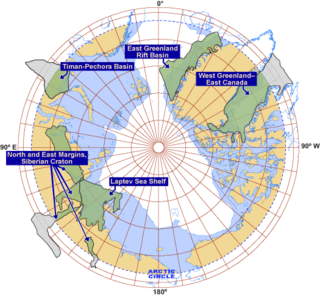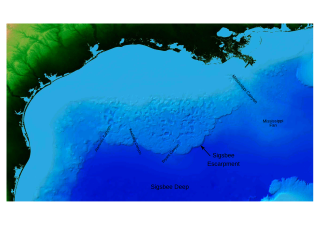Related Research Articles

A blowout is the uncontrolled release of crude oil and/or natural gas from an oil well or gas well after pressure control systems have failed. Modern wells have blowout preventers intended to prevent such an occurrence. An accidental spark during a blowout can lead to a catastrophic oil or gas fire.

The exploration of the Arctic for petroleum is considered to be quite technically challenging. However, recent technological developments, the melting of Arctic permafrost, as well as relatively high oil prices, have allowed for exploration. As a result, the region has received significant interest from the petroleum industry.

Deepwater Horizon was an ultra-deepwater, dynamically positioned, semi-submersible offshore drilling rig owned by Transocean and operated by BP. On 20 April 2010, while drilling at the Macondo Prospect, a blowout caused an explosion on the rig that killed 11 crewmen and ignited a fireball visible from 40 miles (64 km) away. The fire was inextinguishable and, two days later, on 22 April, the Horizon sank, leaving the well gushing at the seabed and causing the largest marine oil spill in history.
Deepwater drilling, or deep well drilling, is the process of creating holes in the Earth's crust using a drilling rig for oil extraction under the deep sea. There are approximately 3400 deepwater wells in the Gulf of Mexico with depths greater than 150 meters.

Offshore drilling for oil and gas on the Atlantic coast of the United States took place from 1947 to the early 1980s. Oil companies drilled five wells in Atlantic Florida state waters and 51 exploratory wells on federal leases on the outer continental shelf of the Atlantic coast. None of the wells were completed as producing wells. All the leases have now reverted to the government.

Offshore oil and gas in the Gulf of Mexico is a major source of oil and natural gas in the United States. The western and central Gulf of Mexico, which includes offshore Texas, Louisiana, Mississippi, and Alabama, is one of the major petroleum-producing areas of the United States. Oil production from US federal waters in the Gulf of Mexico reached an all-time annual high of 1.65 million barrels per day in 2017. Oil production is expected to continue the upward trend in 2018 and 2019, based on ten new oil fields which are planned to start production in those years. According to the Energy Information Administration, "Gulf of Mexico federal offshore oil production accounts for 15% of total U.S. crude oil production and federal offshore natural gas production in the Gulf accounts for 5% of total U.S. dry production."

The Deepwater Horizon drilling rig explosion was an April 20, 2010 explosion and subsequent fire on the Deepwater Horizon semi-submersible mobile offshore drilling unit, which was owned and operated by Transocean and drilling for BP in the Macondo Prospect oil field about 40 miles (64 km) southeast off the Louisiana coast. The explosion and subsequent fire resulted in the sinking of the Deepwater Horizon and the deaths of 11 workers; 17 others were injured. The same blowout that caused the explosion also caused an oil well fire and a massive offshore oil spill in the Gulf of Mexico, considered the largest accidental marine oil spill in the world, and the largest environmental disaster in United States history.
The following is a timeline of the Deepwater Horizon oil spill. It was a massive oil spill in the Gulf of Mexico, the largest offshore spill in U.S. history. It was a result of the well blowout that began with the Deepwater Horizon drilling rig explosion on April 20, 2010.

Keathley Canyon is an undersea canyon in the United States Exclusive Economic Zone in the Gulf of Mexico. The canyon is named for the hydrographic survey ship USNS Sergeant George D. Keathley (T-AGS-35).
Following is a timeline of the Deepwater Horizon oil spill for June 2010.
Following is a timeline of the Deepwater Horizon oil spill for July 2010.
Following is a Timeline of the Deepwater Horizon oil spill for May 2010.
Reactions to the Deepwater Horizon oil spill from various officials and interested parties ranged from blame and outrage at the damage caused by the spill, to calls for greater accountability on the part of the U.S. government and BP, including new legislation dealing with preventative security and clean-up improvements.
Efforts to stem the Deepwater Horizon oil spill were ongoing from the time that the Deepwater Horizon exploded on April 20, 2010 until the well was sealed by a cap on July 15, 2010. Various species of dolphins and other mammals, birds, and the endangered sea turtles have been killed either directly or indirectly by the oil spill. The Deepwater Horizon spill has surpassed in volume the 1989 Exxon Valdez oil spill as the largest ever to originate in U.S.-controlled waters; it is comparable to the 1979 Ixtoc I oil spill in total volume released.
The Orphan Basin is an area approximately 400 km east-north-east of St. John's, Newfoundland and Labrador in Canada. Two exploratory oil wells have been drilled there as it is estimated to have oil reserves of 6-8 billion barrels. Chevron intends to drill a third well in 2012.
The Helix fast-response system (HFRS) is a deep-sea oil spill response plan licensed by HWCG LLC, a consortium of 16 independent oil companies, to respond to subsea well incidents. Helix Energy Solutions Group designed the Helix fast-response system based on techniques used to contain the 2010 Gulf of Mexico oil spill. On February 28, 2011 the drilling moratorium imposed as a result of the spill ended when the United States Department of the Interior approved the first drilling permit based on the availability of the HFRS to offshore oil companies.

Arctic Challenger is a barge which has been converted by Superior Energy Services for use in the Arctic drilling operations of Shell Oil Company. This barge is designed to function as a "novel engineering solution" which they refer to as an Arctic Containment System to respond should a blowout event occur at drilling sites in the Beaufort or Chukchi Seas. According to testimony provided to Senator Mark Begich on 11 October 2012, Coast Guard Rear Admiral Thomas Ostebo said the certification for the Shell spill barge Arctic Challenger to operate in Alaska was given on the 10th of October at the Bellingham, Washington shipyard where it was constructed. Ostebo is commander of the Coast Guard’s 17th district, which covers Alaska.

The Deepwater Horizon oil spill occurred between 10 April and 19 September 2010 in the Gulf of Mexico. A variety of techniques were used to address fundamental strategies for addressing the spilled oil, which were: to contain oil on the surface, dispersal, and removal. While most of the oil drilled off Louisiana is a lighter crude, the leaking oil was of a heavier blend which contained asphalt-like substances. According to Ed Overton, who heads a federal chemical hazard assessment team for oil spills, this type of oil emulsifies well. Once it becomes emulsified, it no longer evaporates as quickly as regular oil, does not rinse off as easily, cannot be broken down by microbes as easily, and does not burn as well. "That type of mixture essentially removes all the best oil clean-up weapons", Overton said.
Modular capture vessels are converted oil tankers which can capture hydrocarbons or other liquid contaminations from leaking oil and gas wells in deep sea areas. MCV's in general operate as normal oil tankers and provide capture and containment services in the event of a potential deepwater well control incident.
HWCG LLC is a not-for-profit consortium of deepwater oil and gas companies. HWCG maintains a comprehensive deepwater well containment response model that can be activated immediately in the event of a US Gulf of Mexico subsea blowout. It comprises oil and gas companies operating in the Gulf and incorporates the consortium’s generic well containment plan. HWCG has a healthy mutual aid component whereby HWCG members will respond and support another member’s incident.
References
- ↑ Brady, Jeff (April 20, 2020). "10 Years After Deepwater Horizon Oil Spill, Industry Says It's Better Prepared". NPR .
- ↑ Coombs, Bertha (July 21, 2010). "Four Energy Companies Form Oil Spill Reaction Team". CNBC .
- ↑ KOCH, WENDY (April 20, 2015). "Is Deepwater Drilling Safer, 5 Years After Worst Oil Spill?". National Geographic .
- ↑ Brady, Jeff (March 25, 2014). "Why Oil Drilling Is Both Safer And Riskier Since Exxon Valdez". KPBS. NPR.